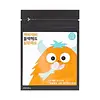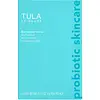What's inside
What's inside
 Key Ingredients
Key Ingredients

No key ingredients
 Benefits
Benefits

 Concerns
Concerns

 Ingredients Side-by-side
Ingredients Side-by-side

Water
Skin ConditioningCellulose
AbsorbentButylene Glycol
HumectantGlycerin
HumectantDipropylene Glycol
HumectantQuaternium-60
Propylene Glycol
HumectantMicrocrystalline Cellulose
AbsorbentAlcohol
AntimicrobialCarbomer
Emulsion Stabilising1,2-Hexanediol
Skin ConditioningParfum
MaskingSodium Chloride
MaskingGlycyrrhiza Glabra Root Extract
BleachingZingiber Officinale Root Extract
MaskingCoptis Chinensis Root Extract
AntioxidantCamellia Sinensis Leaf Extract
AntimicrobialEthylhexylglycerin
Skin ConditioningDisodium EDTA
PEG-60 Hydrogenated Castor Oil
EmulsifyingBidens Pilosa Extract
HumectantEucalyptus Globulus Leaf Oil
PerfumingCitric Acid
BufferingSalicylic Acid
MaskingCharcoal Powder
AbrasiveWater, Cellulose, Butylene Glycol, Glycerin, Dipropylene Glycol, Quaternium-60, Propylene Glycol, Microcrystalline Cellulose, Alcohol, Carbomer, 1,2-Hexanediol, Parfum, Sodium Chloride, Glycyrrhiza Glabra Root Extract, Zingiber Officinale Root Extract, Coptis Chinensis Root Extract, Camellia Sinensis Leaf Extract, Ethylhexylglycerin, Disodium EDTA, PEG-60 Hydrogenated Castor Oil, Bidens Pilosa Extract, Eucalyptus Globulus Leaf Oil, Citric Acid, Salicylic Acid, Charcoal Powder
Water
Skin ConditioningDipropylene Glycol
HumectantQuaternium-60
Propylene Glycol
HumectantCellulose
AbsorbentGlycerin
HumectantPEG-7 Glyceryl Cocoate
EmulsifyingPEG-20 Glyceryl Triisostearate
EmollientCarbomer
Emulsion StabilisingAlcohol Denat.
Antimicrobial1,2-Hexanediol
Skin ConditioningLactic Acid
BufferingLactococcus Ferment Lysate
Skin ConditioningCarica Papaya Fruit Extract
Skin ConditioningSalix Alba Bark Extract
AstringentHamamelis Virginiana Extract
AntiseborrhoeicPEG-60 Hydrogenated Castor Oil
EmulsifyingSodium Chloride
MaskingSodium Benzoate
MaskingEthylhexylglycerin
Skin ConditioningParfum
MaskingPhenoxyethanol
PreservativeWater, Dipropylene Glycol, Quaternium-60, Propylene Glycol, Cellulose, Glycerin, PEG-7 Glyceryl Cocoate, PEG-20 Glyceryl Triisostearate, Carbomer, Alcohol Denat., 1,2-Hexanediol, Lactic Acid, Lactococcus Ferment Lysate, Carica Papaya Fruit Extract, Salix Alba Bark Extract, Hamamelis Virginiana Extract, PEG-60 Hydrogenated Castor Oil, Sodium Chloride, Sodium Benzoate, Ethylhexylglycerin, Parfum, Phenoxyethanol
Ingredients Explained
These ingredients are found in both products.
Ingredients higher up in an ingredient list are typically present in a larger amount.
1,2-Hexanediol is a synthetic liquid and another multi-functional powerhouse.
It is a:
- Humectant, drawing moisture into the skin
- Emollient, helping to soften skin
- Solvent, dispersing and stabilizing formulas
- Preservative booster, enhancing the antimicrobial activity of other preservatives
Carbomer is a polymer of acrylic acid. Its main role is to create a gel consistency.
A high amount of carbomer can cause pilling or balling up of products. Don't worry, most products contain 1% or less of carbomer.
Cellulose is the main component of plant cell walls. It is used as an emulsifier, absorbent, and texture enhancer.
This ingredient has many functions:
Fun fact: Cellulose is the most abundant form of organic polymer on Earth.
Learn more about CelluloseDipropylene Glycol is a synthetically created humectant, stabilizer, and solvent.
This ingredient helps:
Dipropylene glycol is technically an alcohol, but it belongs to the glycol family (often considered part of the ‘good’ alcohols). This means it is hydrating and gentle on skin unlike drying solvent alcohols like denatured alcohol.
As a masking agent, Dipropylene Glycol can be used to cover the smell of other ingredients. However, it does not have a scent.
Studies show Dipropylene Glycol is considered safe to use in skincare.
Learn more about Dipropylene GlycolEthylhexylglycerin (we can't pronounce this either) is commonly used as a preservative and skin softener. It is derived from glyceryl.
You might see Ethylhexylglycerin often paired with other preservatives such as phenoxyethanol. Ethylhexylglycerin has been found to increase the effectiveness of these other preservatives.
Glycerin is already naturally found in your skin. It helps moisturize and protect your skin.
A study from 2016 found glycerin to be more effective as a humectant than AHAs and hyaluronic acid.
As a humectant, it helps the skin stay hydrated by pulling moisture to your skin. The low molecular weight of glycerin allows it to pull moisture into the deeper layers of your skin.
Hydrated skin improves your skin barrier; Your skin barrier helps protect against irritants and bacteria.
Glycerin has also been found to have antimicrobial and antiviral properties. Due to these properties, glycerin is often used in wound and burn treatments.
In cosmetics, glycerin is usually derived from plants such as soybean or palm. However, it can also be sourced from animals, such as tallow or animal fat.
This ingredient is organic, colorless, odorless, and non-toxic.
Glycerin is the name for this ingredient in American English. British English uses Glycerol/Glycerine.
Learn more about GlycerinParfum is a catch-all term for an ingredient or more that is used to give a scent to products.
Also called "fragrance", this ingredient can be a blend of hundreds of chemicals or plant oils. This means every product with "fragrance" or "parfum" in the ingredients list is a different mixture.
For instance, Habanolide is a proprietary trade name for a specific aroma chemical. When used as a fragrance ingredient in cosmetics, most aroma chemicals fall under the broad labeling category of “FRAGRANCE” or “PARFUM” according to EU and US regulations.
The term 'parfum' or 'fragrance' is not regulated in many countries. In many cases, it is up to the brand to define this term.
For instance, many brands choose to label themselves as "fragrance-free" because they are not using synthetic fragrances. However, their products may still contain ingredients such as essential oils that are considered a fragrance by INCI standards.
One example is Calendula flower extract. Calendula is an essential oil that still imparts a scent or 'fragrance'.
Depending on the blend, the ingredients in the mixture can cause allergies and sensitivities on the skin. Some ingredients that are known EU allergens include linalool and citronellol.
Parfum can also be used to mask or cover an unpleasant scent.
The bottom line is: not all fragrances/parfum/ingredients are created equally. If you are worried about fragrances, we recommend taking a closer look at an ingredient. And of course, we always recommend speaking with a professional.
Learn more about ParfumPeg-60 Hydrogenated Castor Oil comes from hydrogenated castor oil. It is a solubilizer and emulsifier.
As a solubilizer, it helps dissolve ingredients into a water-based version. It is also an emulsifer. Emulsifier help prevent oils and water from separating. Both these properties help create evenly-spread and uniform products.
Basically, Peg-60 Hydrogenated Castor Oil helps hold ingredients together.
Learn more about PEG-60 Hydrogenated Castor OilPropylene Glycol is an odorless, colorless liquid. As a humectant, it helps skin retain moisture. It also aids in delivering active ingredients.
Another role of this ingredient is preventing a product from melting or freezing. Propylene glycol also adds antimicrobrial properties to a product, elongating product lifespan.
This ingredient is considered an organic alcohol and commonly added into both cosmetics and foods.
Those with sensitive skin or conditions may develop a rash when using this ingredient.
Learn more about Propylene GlycolWe don't have a description for Quaternium-60 yet.
Chances are, you eat sodium chloride every day. Sodium Chloride is also known as table salt.
This ingredient has many purposes in skincare: thickener, emulsifier, and exfoliator.
You'll most likely find this ingredient in cleansers where it is used to create a gel-like texture. As an emulsifier, it also prevents ingredients from separating.
There is much debate on whether this ingredient is comedogenic. The short answer - comedogenic ratings don't tell the whole story. Learn more about comegodenic ratings here.
The concensus about this ingredient causing acne seems to be divided. Research is needed to understand if this ingredient does cause acne.
Scrubs may use salt as the primary exfoliating ingredient.
Learn more about Sodium ChlorideWater. It's the most common cosmetic ingredient of all. You'll usually see it at the top of ingredient lists, meaning that it makes up the largest part of the product.
So why is it so popular? Water most often acts as a solvent - this means that it helps dissolve other ingredients into the formulation.
You'll also recognize water as that liquid we all need to stay alive. If you see this, drink a glass of water. Stay hydrated!
Learn more about Water